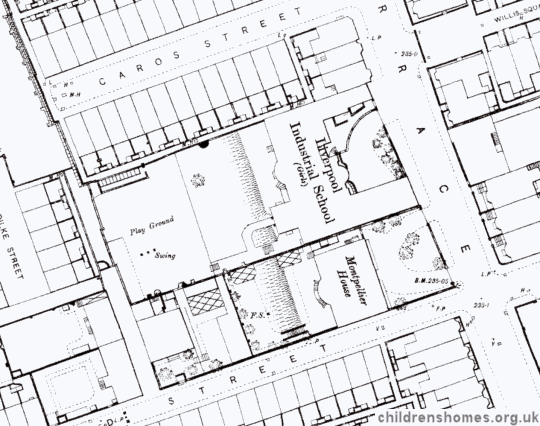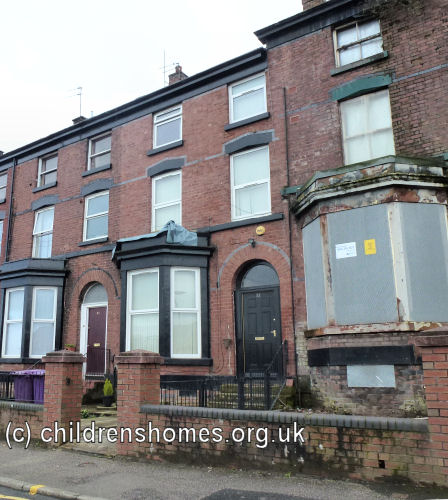Liverpool Industrial School for Girls, Liverpool, Lancashire
The Liverpool Industrial School for Girls was founded in 1878 as separate establishment for girls from the Ragged Industrial School at Everton Terrace which was changing from a mixed institution to being boys-only. The new School was located at 27 (later renumbered as 39) Northumberland Terrace, Liverpool and was officially certified to begin operation on January 5th, 1878, with accommodation for 100 girls. The School's first inmates included girls who had only recently been transferred to Everton Terrace from Liverpool's Holy Trinity Industrial School and the Bolton Industrial School, which had also become boys-only. The superintendent at Northumberland Terrace was Miss Louisa P. Skinner.
The School site is shown on the 1891 map below.

Liverpool Industrial School for Girls, Branch Home site, Liverpool, c.1891.
An inspection of the establishment in May, 1878 found the rooms to be overcrowded, and the number of inmates (106) above the official limit for the building. A year later it was recorded that an adjoining house had been taken into occupation to provide additional space. The girls washed their own clothing, and made and mended the boys' shirts for the Everton Terrace School. The older girls helped with the cooking and the household work, and also took care of the very young children, of whom there were a great many. Some of the older girls received lessons in practical cookery. A system of marks was introduced where rewards and privileges could be earned by good conduct.
The premises were gradually extended and improved. In 1887, a large sum was expended in providing a new sewing-room, a room for the schoolmistress, and a new dormitory. All the children now slept under same roof. In 1893, the laundry was greatly improved, and a new fire escape added to the building.
A report in 1896 described the School as being located in a former private house with wings added on either side, a small garden in front, and a very fair playground at the back with some grass and some garden plots. The playroom was of a fair size and had a number of boxes for the girl' 'treasures'. The small laundry employed several girls and took in some washing from private households. The training for domestic service was pretty complete, with domestic economy receiving particular attention, as well as knitting, sewing and dressmaking. The demand for girls as servants was said to be great. Walks were taken once a week, and there were about 20 girls who in turn went on messages. There had been two trips to the seaside and one in brakes to the country. Concerts and magic lantern entertainments were given by the Kyrle Society and other friends. A museum was being formed and there were about 250 books in the School's library. It was suggested that the School was probably too large numerically, and would benefit from a reduction of the number of inmates.
Miss Skinner, the School's superintendent since its opening, died in 1902. She was replaced by Mrs Deeks who in turned was succeeded by Miss P. Carver on April 1st, 1903. Miss A. Lee became superintendent on March 17th, 1908, and left March 30th, 1909. Miss C. Levers took charge on May 5th, 1909.
By 1909, free and applied gymnastics were being taken by the whole school under expert instruction, and simple Swedish drill was given to the girls in two divisions by the class teachers. A camping trip to the Isle of Man took place in the summer.
On January 2nd, 1912, an Auxiliary Home was opened at 52 St Domingo Vale, Liverpool. It provided supervised hostel-style accommodation for girls leaving, or on licence from, the School and taking up outside employment. Girls between situations could also make use of the Home. On April 23rd, 1912, part of the property was re-certified as being 'additional premises' for the main School, with accommodation for six girls. On July 3rd, 1920, the certificate for the 'additional premises' was resigned, with the same being done for the Auxiliary Home as of 23rd December, 1921.

Liverpool Girls' Industrial School, Auxiliary Home at 52 St Domingo Vale, 2013. © Peter Higginbotham
Following a steady decline in the numbers being placed at the School, it was formally closed on January 4th, 1922. The site was subsequently used for a period as a hospital. The buildings no longer survive.
Records
Note: many repositories impose a closure period of up to 100 years for records identifying individuals. Before travelling a long distance, always check that the records you want to consult will be available.
- None identfied at present — any information welcome.
Census
Bibliography
- Higginbotham, Peter Children's Homes: A History of Institutional Care for Britain's Young (2017, Pen & Sword)
- Mahood, Linda Policing Gender, Class and Family: Britain, 1850-1940 (1995, Univeristy of Alberta Press)
- Prahms, Wendy Newcastle Ragged and Industrial School (2006, The History Press)
Links
- None noted at present.
Except where indicated, this page () © Peter Higginbotham. Contents may not be reproduced without permission.


